




Manitoba Beef Producers (MBP) is accepting applications until Friday, December 13, 2024 for consideration for the local awarding of The Environmental Stewardship Award (TESA).
Since 1996, TESA has recognized producers who go above and beyond standard industry conservation practices and set positive examples for other cattle producers and the general public. As stewards of a vast portion of the Canadian landscape, Canada’s beef cattle producers play a significant role in protecting and enhancing the environment. They continuously strive to improve existing stewardship conservation practices to create a sustainable future – always farming for tomorrow.
At the local level, a producer receives provincial recognition for their outstanding environmental contributions. In Manitoba, this occurs in conjunction with MBP’s annual general meeting in February. All provincial award recipients then move forward to compete for national recognition from the Canadian Cattle Association (CCA). The national TESA recipient
“
is announced during the CCA’s semi-annual meeting held in August in conjunction with the Canadian Beef Industry Conference.
Each nominee exemplifies significant innovation and attention to a wide range of environmental stewardship aspects in their farm or ranch operation. Such innovations extend beneficially to areas far beyond their land, including water, wildlife and air.
How to Nominate
All beef cattle operations in Canada are eligible to apply for consideration for TESA. Interested producers can either nominate themselves, or be nominated by another individual or an organization. All methods are equally encouraged. More details and the application form can be found at: https://www.cattle.ca/sustainability/tesa
Note: If you are a producer who is considering self-nomination, MBP can provide you with guidance and suggestions on completing the application process. The completed application form, along with all
Dean Laval Laval Family Farm, Deloraine, MB Farming is in my blood. My grandparents farmed, my parents farmed, I farm, and now my kids are farming. You keep going.”









supporting documentation (such as letters of support, photos and/or videos), is to be submitted to Manitoba Beef Producers by email to info@mbbeef.ca no later than Friday, December 13, 2024. If you have questions, please contact the MBP office at 204-772-4542.


At the time of writing this, we’re right into our fall district meetings and have been very busy with those and other in-person and virtual meetings. As we see our federal and provincial governments head back into their respective legislative sessions with many different pieces of legislation on the table that require analysis, it makes for a quite busy advocacy schedule for groups like MBP.
Of note, in early October Manitoba Beef Producers held a successful outreach event to our provincial government in the form of a Lunch at the Legislature, with many of the cabinet ministers, Members of the Legislature and government staff with whom MBP regularly deals in attendance. This provided a valuable opportunity to make good connections with the elected members, many of them representing urban or more northerly constituencies. We talked about the good news story that we as cattle producers have to tell about the high quality animal care we provide, the nutritious food we produce, as well as the environmental benefits provided by having cattle on the landscape. It was a great opportunity to build connections across party lines and to share the benefits and importance of our industry with those who might not have a firsthand experience with it. We as beef producers do have a good news story to tell and it is nice to get the opportunity to do so with the people who shape legislation and policies affecting our sector. Check out some event photos on page 15.
Aside from these more local and provincial discussions, a large focus on the national side, at this point, continues to be Bill C-282 ‒ An Act to amend the Department of Foreign Affairs, Trade and Development Act (supply management). At the time of writing this, the bill is still working its way through the Senate, however, it may have moved along by the time this edition of Cattle Country hits your mailbox. As I have previously mentioned, Bill C-282 is a bill to amend Canada’s foreign trade act that removes supply management from any future trade negotiations. It’s a private members bill put forward by a member of the Bloc Quebecois.
Simply put, this is a bill that would put an out-

MATTHEW ATKINSON President’s Column
ward-facing law in effect, for all the world to see, that ties the hands of our trade negotiators. It would mean that under no circumstance could any market access be given for other countries to sell agricultural items into Canada that we as Canadians produce under a quota-based system. This has, and continues to be, a huge concern for us as beef producers, along with other commodities that export.
In Canada, we export more than half of the beef we produce and we need good trade relationships with the nations that we sell to. This has always been something we have had and Canada is seen as a country that holds itself and others to a very high standard when it comes to fair and rules-based trade. We have heard from many experts and other nations that even the fact that Canada is willing to entertain this idea reflects negatively on us and should not be happening.
Unfortunately, in a lot of the debate and negotiation around this, it has been turned into a discussion over the benefits and importance of supply management in Canada. To be completely clear, nobody is putting supply management on trial in Canada. However, we as exporters are definitely concerned when a bill like this would essentially pick a favorite among not just our agricultural commodities, but conceivably everything Canada produces that could be destined for export markets.
This issue has been something that has been extensively worked on by the Canadian beef sector, both provincially and nationally and has really seen all of our strong organizations come together to advocate at this issue from different angles to try and prevent it from becoming law. This has been on our industry’s radar and getting advocacy attention since it was originally brought forward in the House of Commons in 2022. And while it was strategically monitored and advocated

Manitoba Habitat Conservancy is a non-profit organization working to conserve and enhance Manitoba’s natural landscapes in cooperation with landowners.
Learn more at mbhabitat.ca or call 204.784.4350
T 1 ALFRED EPP Boissevain-Morton, Brenda-Waskada, Grassland, Deloraine-Winchester, and Two Borders
DISTRIC T 2
MARK SCHRAM
Argyle, Cartwright-Roblin, KillarneyTurtle Mountain, Lorne, Louise, Pembina, and Prairie Lakes
DISTRIC T 3
ANDRE STEPPLER
Cartier, Du erin, Grey, MacDonald, Portage la Prairie, Rhineland, Roland, Stanley, Thompson, Montcalm, Morris, and Ritchot
DISTRIC T 4 BYRON FALK De Salaberry, Emerson-Franklin, Hanover, La Broquerie, Piney and Stuartburn, Montcalm, Morris, Ritchot, Spring eld, Ste. Anne, Taché, R.M. of Piney and Reynolds
DISTRIC T 5 STEVEN MANNS Cornwallis, Elton, Norfolk-Treherne, North Norfolk, Oakland-Wawanesa, Glenboro-South Cypress, and Victoria
DISTRIC T 6 BRIAN ENGLISH Pipestone, Riverdale, Sifton, Souris-Glenwood, Wallace-Woodworth, and Whitehead
DISTRIC T 7 T YLER FULTON 2ND VICE-PRESIDENT Ellice-Archie, Hamiota, Prairie-View, Riding Mountain West, Rossburn, Russell-Binscarth, and Yellowhead
DISTRIC T 8 MATTHEW ATKINSON Clanwilliam-Erickson, Glenella-Lansdowne, Harrison-Park, Minto-Odanah, Oakview, North Cypress-Langford, Rosedale, and West Lake-Gladstone
against throughout, I don’t think that any of us could have foreseen a circumstance where the Bloc is using it as a condition of their support for government, and saying they will vote to bring down the minority Liberal government if it is not passed.
I hope by the time everyone reads this column Bill C-282 is a non-issue as it didn’t go ahead. However, regardless of the outcome, it is important to know now much effort has gone into trying to prevent this from advancing and how our provincial beef groups across Canada, as well as Canadian Cattle Association have really pulled together to try and prevent this from becoming law. MBP also recognizes the many producers who have reached out to their elected officials to express concerns about this proposed legislation. It is so important that these representatives know about the potential negative consequences of the various bills and regulations that are presented to them and consider them before they vote on them.
Finally, on pages 8 and 9 you will see the essays from this year’s recipients of the MBP scholarship program. MBP awards six $1,000 scholarships annually for MBP members or their children attending a university, college, other post-secondary institution or pursuing trades training. Preference is given to those pursuing a field of study related to agriculture or to those acquiring a skilled trade or pursuing a career that would be beneficial to the rural economy. Additionally, this year’s recipients received a top-up in memory of the late Larry Schweitzer, a former District 7 director and past president of both the Manitoba Cattle Producers Association (MCPA) and the National Cattle Feeders Association. He passed away in December 2023. Larry’s widow Audrey Kuik-Schweitzer generously asked that donations be made in his honor toward a number of initiatives, including contributions towards this year’s scholarships. These additional monies will certainly help the students with their studies and MBP sincerely thanks Audrey for thinking of future industry leaders and taking this approach in memory of Larry and his service to the sector.

President: Brooke Canart 204-851-2531
Congratulations to the MSA 2023 A.O Henuset Ambassador Award WLB Livestock, Douglas, MB 2024 Commercial Breeder of the Year Glen Abbey Farm , Glenboro, MB
Nov. 21st Pembina Triangle Simmental Assoc. 44th Annual Sale Cypress River, Mb
Nov. 23rd Antrim Simmentals Complete Dispersal Sale Neepawa, Mb
Nov 28th Associate Invitational Simmental Sale FarmGateTimedAuctions.ca
Dec 3rd Keystone Konnection 46th Annual Sale Brandon, Mb
Dec 5th Maple Lake Stock Farms Fall Bred Heifer Sale Hartney, Mb
Dec 8-9th Rendezvous Farms Complete Herd Dispersal Ste Rose, Mb
Dec 10th Northern Light Bred Heifer & 2 Year Old Bull Sale Rossburn, Mb
Dec 10th Cream of the Crop Simmental Sale FarmGateTimedAuctions.ca
Dec 11th Premium Picks Simmental Sale Kenton, Mb
Dec 13th OPT Bred For Success 1st Annual Female Event Darlingford, Mb
Dec 14th Transcon’s Season Wrap Up Bull & Female Sale Neepawa, Mb
Dec 15th Bonchuk Farms Female Production Sale McAuley, Mb

Secretary: Sandra Brigden 403-638-7741 sandra.mbsimmental@gmail.com www.mbsimmental.com view our facebook page or website for
DISTRIC T 9 TREVOR SUND Alexander, Brokenhead, East St. Paul, Lac Du Bonnet, Rockwood, Rosser, St. Andrews, St. Clements, St. Francois Xavier, West St. Paul, Whitemouth, Woodlands, LGD of Pinawa, Reynolds, Spring eld, Ste. Anne, and Taché
DISTRIC T 10
MIKE DUGUID SECRETARY Armstrong, Bifrost-Riverton, Fisher, and Gimli
DISTRIC T 11
ARVID NOTT VEIT Coldwell, Grahamdale, St. Laurent, and West Interlake
DISTRIC T 12 MARK GOOD TREASURER Alonsa, Lakeshore, McCreary, and Ste. Rose
Cousins
to
Happy fall everyone,
We have enjoyed some extended warm weather this fall, so I hope you’ve gotten the needed feed up for the winter. It was a decent production season, helping to replenish feed stocks. Here’s hoping your fall run calves have also gotten good prices. Markets have been strong lately and the outlook is favorable.
As I write this, we have been prepping for our district meetings. Thank you in advance to all of those who attend. My column is short and sweet this month, as I look forward to gaining lots of feedback from members over the next few weeks.
The key discussion we hope to have at this year’s meetings is livestock inspection and whether the service should be expanded and be mandatory in Manitoba. This matter has been the subject of a long-standing debate in our industry. With illegal activity related to Manitoba cattle in last couple of years, this topic is front and center again.
Manitoba is a unique location in terms of the sector’s layout. This is primarily a cow/calf province, with some backgrounding and feeding occurring at a smaller rate than in Saskatchewan and Alberta. Manitoba is also in the middle of two regions that differ in terms of inspection. Ontario does not have a specific inspection

CARSON CALLUM General Manager’s Column
service, and producers there don’t commonly brand, whereas west of Manitoba all cattle are inspected. This has led to challenges in the implementation of inspection in Manitoba, when there are cattle moving east and west.
With Manitoba’s differences in inspection compared to our western counterparts in mind, it will be crucial that the principles used for livestock inspection services are developed and adapted to best serve the needs of the Manitoba cattle industry. That’s why your feedback at the district meetings is crucial.
Currently in Manitoba, cattle sold to the west require inspection before leaving the auction marts. If there were a change to mandatory inspection service in Manitoba, it would mean having inspectors at the point of producer offload as opposed to when cattle are leaving the auction mart. It changes the stage at which they are inspected, but many auction marts already have
an inspector. Adding more inspection staff under this service would be the main change in Manitoba.
Following our fall meetings, MBP will consolidate the feedback for further discussion with our Board of Directors. We then plan to host a couple of producer town halls to review the feedback to date and to facilitate more discussions. For expanded inspection to be successful, Manitoba’s cattle industry needs to be strongly behind the initiative and ensure it meets the needs of our province and of industry partners in Canada. At the end of the day, this type of service expansion would need to be facilitated through legislative and regulatory changes that would be made by the Manitoba government, which is also interested to see where producers currently stand on the matter. Without solid industry consensus, we are doubtful to see movement on it.
At these district meetings, you will also get an update on various other topics MBP has been working on. These include items such as predation, Livestock Price Insurance, traceability, trade and more.
I look forward to these meetings to gain feedback. I also look forward to seeing many of you that I haven’t seen in a while. It’s a great way to connect and also enjoy a wonderful beef meal.
Until next time, Carson

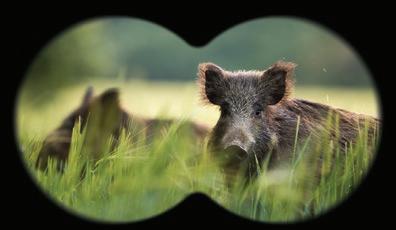
BY ANGELA LOVELL
The following are some highlights from various speakers at the 2024 Canadian Beef Industry Conference (CBIC) held in Saskatoon in August.
Becky McCray – The Idea Friendly Method:
Open Up to New Ideas
It’s easy to get stuck in old ways that can prevent people, and whole communities, from moving forward. Often, because people fear failure and overestimate risk, ideas and initiatives become bogged down in endless discussions, and can lead to conflict within communities. These are problems that Becky McCray helps small and rural communities across North America to move beyond using what she calls the Idea Friendly Method.
As the keynote speaker at this year’s Canadian Beef Industry Conference McCray, who is an Oklahoma rancher and consultant for rural and small-town development, McCray explained that the Idea Friendly Method is the best method to get beyond the kind of community conflicts that can shred community bonds.
“You don’t have to know all the answers as long as you can stay open to new ideas,” she said. “In communities there are people who know the answers to your challenges and you are going to solve them with your own resources, you are the ones that are going to take action and make things better in your community, and you are going to build connections outward to find the resources that make it possible. We can be open to new ideas while we stay rooted in our traditions.”
The Idea Friendly Method has several steps:
1. Gather a crowd.
“Look at your big idea and think about how you could do an activity that people could be a part of and would enjoy doing that would help move you towards your big idea, preferably outside of the traditional meeting room setting,” McCray said.
2. Build Connections
“You are more likely to be successful when you have a supportive group to work with,” McCray said. “Think about how you can build connections around the idea, how you can bring people together from different groups, connect them to resources, and connect them to people that have similar interests and ideas.”
3. Take small steps
Instead of the traditional way of forming a committee and writing a big plan that is discussed over and over until everyone agrees, give people the smallest possible way to start taking action right away.
different groups where they can each play a small role in it. Adults learn by reflecting on experiences, and if that experience connects you with people that are outside your usual group, that gives you the opportunity to learn something new, make a new connection and change the way you are thinking and your way of caring.”
Ranch Disruptors and Mavericks Session
Sometimes on multi-generational farms or ranches, for whatever reason, there isn’t the option for all of the next generation to be a part of things.
Ryan Beierbach, who ranches at Whitewood, Saskatchewan with his wife, Catherine and three children, and Jaclyn Wilson, a cow/calf producer and co-owner of Flying Diamond Ranch, Nebraska were at the Canadian Beef Industry Conference to discuss how they started their ranches on their own from scratch, and how that presented an opportunity to build their operations in a unique way.
Twenty-two years ago, after working off-farm for a while, Beierbach purchased his first 100 cows, rented some land from his grandpa, and started a business selling ranch supplies and tack at rodeos, which became his main income source when BSE struck.
“I spent over half of my time for 10 years selling ranch supplies and tack, and it was subsidizing the cow side,” he says. “We rolled with the punches and when something didn’t work, we’d try something else.”
Eventually, Beierbach, who is Chair of the Canadian Roundtable for Sustainable Beef, bought his current ranch in Saskatchewan where he breeds Angus cows to Hereford bulls, backgrounds calves and sells yearlings and bred heifers.
says. The ranch was the first in the world to sell a group of feedlot steers as NFT’s (non-fungible tokens) through the crypto market.
Wilson does a lot of travelling as part of her advocacy work for the beef industry and is currently Chair of the International Trade Policy Committee for the National Cattlemen’s Beef Association in the United States.
Juggling so many different enterprises can be exhausting, and Beierbach and Wilson admit they sometimes struggle to find balance.
Beierbach says going to meetings and getting out of his immediate circle has helped him learn and grow.
“A lot of people are scared to talk about their mistakes, but if you can own that, you can learn a lot from people who are doing things differently,” he said.
While acknowledging the support of her family, Wilson also emphasizes the importance of a strong network, including people from outside of agriculture.
“Some of the most influential people in my life don’t know what a cow is,” she said. “Be willing to be adaptable and not afraid of change, so you can deal with the ups and downs. We have to keep building ourselves up, recognizing that in order for this industry to survive, we need to come together and support each other.”
Beef on Dairy Offers Opportunities
Along the Value Chain
Another topic of discussion at the Canadian Beef Industry Conference was beef on dairy.
Thanks to advances in genetics, crossbreeding beef on dairy produces animals with many benefits for everyone along the value chain including producers, feeders, packers, and consumers. Beef on dairy animals have improved health, better feed conversion, improved average daily gain, yield, quality grade and carcass cutability. The eating experience is also better because the animals are slaughtered young – under 18 months of age – and have a unique production system where day-old calves are taken from the dairy and brought to a calf ranch to be bottle fed for 40 to 50 days. Then they are weaned and fed for the next year on a high energy dense diet. A beef on dairy animal also produces 40 to 50 per cent less carbon emissions than an animal coming from the native beef cattle chain.
“You don’t have to know all the answers as long as you can stay open to new ideas,” she said. “In communities there are people who know the answers to your challenges and you are going to solve them with your own resources, you are the ones that are going to take action and make things better in your community, and you are going to build connections outward to find the resources that make it possible. We can be open to new ideas while we stay rooted in our traditions.”
“Look at your big idea and think about a small step you can take that would help make that happen, for example, could you send a text message to someone,” McCray said. “We can take one small step and we don’t have to let one failure brand us – it doesn’t mean that we can never try again. Each small step takes us one step closer as we learn from it about what did or didn’t work; each small step moves us forward.”
4. Motivate people
Taking your own action is the best way to entice people who are initially resistant.
“Take a tiny, meaningful action - something that makes a difference,” McCray said. “We have been looking for our volunteers at the highest level of motivation, but put your motivation as the foundation and attract people with even the tiniest levels of motivation. Once you take a small action, you are more likely to take larger steps after.”
Step away from conflict
Stepping away from conflict can be hard because being excluded by community is painful, but it’s necessary to build a strong community.
“People who don’t like your idea or don’t agree with you, those are not your people, don’t worry about them,” McCray says. “You will build a stronger community through experiences that bring people together across
“What works for us is trying to get extra value out of selling bred heifers,” he says. “We still have a ranch supply and tack business selling forage seed, electric fence and mineral.”
Wilson comes from a four-generation ranching family and 22 years ago when she came back to the farm from university after studying business and economics, she realized that it wasn’t feasible for her to take an ownership stake in the farm. So, in 2011 she started a genetic company breeding embryos that built enough equity for her to lease another ranch and purchase 1,200 head of cows.
“I started the business because at that point my parents’ mindset was to divide everything equally between me and my [non-farming] brother,” Wilson said. “I knew there was no way I could survive on 50 head of cows and be able to lease my brother out, buy more cows, and lease the equipment and everything from him. So, I built a business from the ground up.”
Fast forward to five years ago and she has become an equal partner in the farm with her dad, managing his and her own herd, and a beef business – Flying Diamond Beef – that markets direct to consumers. She has developed a flexible and adaptive marketing approach.
“I usually sell almost everything as replacement quality females that I don’t keep, and sell some cattle via video, auction barn, program cattle, or send some to our beef business all depending on the market cycle,” she
The practice is well established in the United States, and some dairies are breeding 60 per cent of their cows to a beef animal due to high prices for the day-olds (currently around USD800 per head).
Although Canada’s supply management system does present some barriers, Dr. Kee Jim, Global Head of Animal Health and Strategy at Telus Agriculture believes there are opportunities as beef cow numbers continue to decline on both sides of the border.
“This is the most significant development I have seen in term of opportunity to produce something different than in the past, where you can focus on improving genetics and get paid for it,” Jim told attendees at the CBIC. “The big opportunity for native cattle is in the seed stock producers suddenly have major customers in the beef on dairy space.”
Because dairy systems exclusively use AI, there are complete and accurate records available all the way from the animal’s birth to the packer that creates an aligned value chain.
“No one has been able to do this at scale in the beef cattle world, but you can do it in this system,” Jim said.
Brett Gardiner – CBIC Closing Keynote Speaker Chase the good moment
“Chase the good moment,” said world famous rodeo announcer and speaker Brett Gardiner during his closing keynote speech at the Canadian Beef Industry Conference in August. “That means we have to be intentional in what we want to do – making changes or improvements doesn’t happen by accident – we do that. Choose to chase what is good in the world.”
Gardiner talked candidly and openly about his own long mental health journey and shared his insight into how people can approach mental health challenges in their own lives.
After more than 20 years in his successful career, Gardiner says he felt empty, alone, and scared.
“My mental health was in a poor place, but I didn’t know what mental health was, and I didn’t know what to do with it,” he said. “I didn’t understand that mental health, when we don’t address it, can find its way into mental illness. If had to label me with something, it would be that I was burned out, and that progressed to anxiety, and my anxiety progressed to depression.”
Anxiety and depression are like opposite sides of the same coin, Gardiner said.
“When we start to find our life full of anxiety, and if we are unable to manage that, at some point it slides itself into depression,” he said. “Our body and our brain does an incredible job of fighting anxiety – it’s giving us a warning.”
When we don’t heed the warning signs of poor mental health ‒ things like mood swings, sadness, withdrawal, irritability, outbursts, loss of interest in things, sudden extreme shifts in behavior, sleep patterns changes, appetite changes and substance abuse ‒ anxiety takes over and can becomes debilitating, but it’s important for people to understand that they are not alone.
“For me, when I started to reach out for help, one of the biggest things I learned was I was so not alone in this, there were so many people that I loved and admired that
felt the same way,” he said. “What I needed was often permission to say just because you are the announcer of the year at the Calgary Stampede, it’s OK for you not to be OK. I needed to learn acceptance; we feel things and those feelings are not going to go away. We have to accept that we have them. Acceptance is a pathway to freedom.”
The path to mental health
The following are the overarching themes that Gardiner has learned and shares with other to help them in their journey towards mental health and fitness.
Mindset matters
If you don’t have the mindset to be open and honest and vulnerable enough [mental health] is not going to happen. Mindsets can change, so you have to accept there is something you need to change and be willing to make a change. We often will spend the time to network and learn how we can get better as producers, but are we doing that for ourselves?
Times are changing
We are in an age of cognitive crisis and people consume more information than ever, so our brains have become a bottleneck. There is so much information going in and we don’t have the tools in our brain to process it all, so it can be overwhelming. That means the tools we used 10 years ago won’t work today.
Education is a superpower
We often don’t have the emotional language (and this is especially true in men) to diagnose ourselves. The most powerful education is learning about ourselves,
how do we tick in respect to our culture, our upbringing? Why did that make me so mad today? We need to learn about ourselves.
Vulnerability
Being willing to live in the gap a little bit longer, even if we don’t like it.
Power is in personalization
Sometimes we have cookie cutter approaches, but what works for you won’t work for me. Keep looking and find something that works for you. Therapy is not for everybody. Figure out what resonates with you and how you are going to do it. Set an emotional goal and a personal goal every day.
Confidence in clarity
Know what you need to do. Take time, when in a rational mindset, to put a plan together (not when under pressure). Confidence is in knowing what to do if a situation arises and having a process to deal with it.
Stimulus and response
When something happens, there is a response. We want to know we have the power to make the decision about how we will respond. This is where the power is when we can master our response. We have to renegotiate our contracts with our feelings; put our feelings into free agency. The power to choose our response is where our true freedom lies.
Acceptance with no judgement
When we are responding in a certain way, first we need to say that’s OK, we accept it. But be curious, figure out why, but accept with no judgement.
MBP will be featured at 6:30pm on November 16 on CTV Winnipeg.
Recipes include Carne Asada Nachos, Pulled Beef Sliders with Mango Fennel Slaw, Beef Souvlaki Skewers with Tzatziki & the mini documentary We Produce Genetics featuring the Anderson family of Swan River. Full episodes of Great Tastes can be streamed on demand at greattastesmb.ca or on the @GreatTastesTV YouTube channel. You can follow along with exclusive behind-the-scenes content, recipe tips, meal plans and more at @GreatTastesMB on Facebook and Instagram.
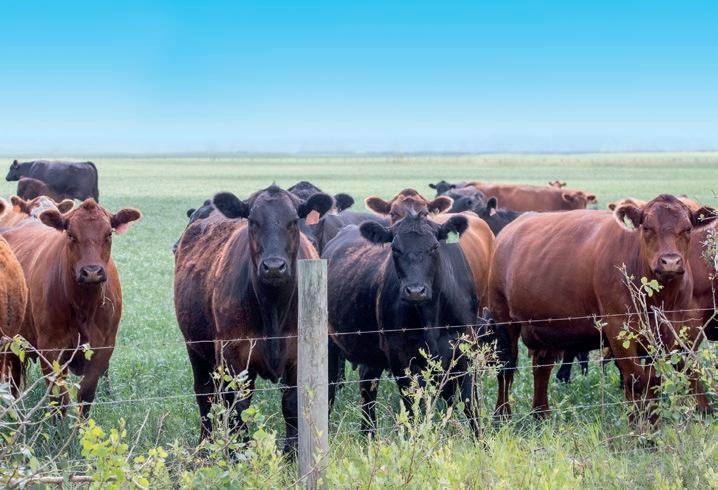
BY ANGELA LOVELL
Producers at the Canadian Beef Industry Conference in Saskatoon this past August got a chance to ask questions of three University of Saskatchewan researchers who are specialists in soil science, cattle behaviour and welfare, and ruminant nutrition. Following are the questions fielded and their answers.
Question: What argument can you provide a beef producer looking to work with a grain producer to capitalize on things like stubble grazing, or utilization of crop residues as part of their feeding program?
Response: Jeff Schoneau (soil scientist)
Part of our research is looking at can we take these areas that grow just kochia and foxtail barley and seed something down, a forage that is palatable that a neighbour who has a cow/calf operation can come in and utilize? When we seeded salt tolerant green wheat grass on saline soils, although it took three or four years to establish, it outyielded the grass on the non-saline soils, and also developed a lot of below ground roots that increased carbon sequestration, improved soil quality and helped decrease the soil surface salinity. Now the neighbour can come in and hay that and it’s a win/win situation.
Question: What does precise manure application mean?
Response: Schoneau
Precise application of manure employs many of the same concepts that we would use for precise application of commercial fertilizer, so using different rates of manure on different parts of the field according to differences in long-term productivity. For the past five years, we have been studying the effects of variable rate manure application, and have found that putting more manure on the hills, less in the depressions and none in the sloughs, where water accumulates, helped to smooth out the production across the field in terms of reducing the variability in crop yield. It also significantly reduced the concentration of phosphate in the water in the field, and had a beneficial effect on reducing production of GHGs especially nitrous oxide.
Question: What is your opinion on seeding polycrops to quickly increase soil organic matter (SOM)?
Response: Schoneau
We did some work with polycrop grazing and although the polycrop wasn’t as productive in terms of dry matter yield as our monocrop barley grazing, when we looked at the roots there was more organic matter put down below into that soil than in the barley,” he responded. “It showed some statistically significant increases in the SOM in the five to 20 cm depth after only two years, so there are some opportunities for gains, but it takes time.
Question: What do you think is going to happen in the next few years in terms of requirements for producers to mitigate pain during procedures like castration?
Response: Diego Moya Fernandez, (animal welfare and behaviour researcher)
I feel that probably in the next 10-year cycle of the Beef Code of Practice, they might implement a reduction in the age where pain medication needs to be provided for animals for castration and de-horning as well. There might be opportunities to develop new products and strategies to make them more effective in the future. We need to make some progress on is to evaluate the efficacy of [pain mitigation] strategies and find out whether they are effective or not in beef cattle.
Question: What are your recommendations for the most applicable strategies that producers can do right now in terms of improving forage and fiber digestion to reduce methane emissions?
Response: Gabriel Ribeiro (animal nutrition researcher)
One of the biggest things that can make a difference is forage quality, so if we can manage forages to have better forage quality, you would have, right away, a reduction in methane production per pound of meat. It can be a challenge to do that, so then it’s how you design diets; there are a few options out there right now that you can use, and using an oil or fat is one of them.
Question: If you had double the research budget that you have now, what would you tackle?
Response: All researchers
Ribeiro: We see a lot of pressure to do things to reduce the environmental impact of beef cattle and we would extend our work in this area into larger projects because if you want to develop biomarkers, we need a lot of phenotypes to match to DNA and look into developing biomarkers for EPDs or whatever you are going to do to select animals.
Schoneau: When we are looking at changes in soil, we need long term trials to document what is happening over the long term and prove some of the models.
Diageo: More animals or length in trials to allow us to test for longer term effects. When you measure behaviour, there is a lot of variability in the same herd, so it’s hard to develop a strategy for measuring pain response. To address that you need to have more animals so we understand why some are reacting one way and others are reacting another way.


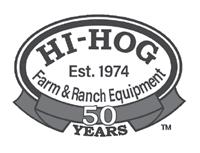
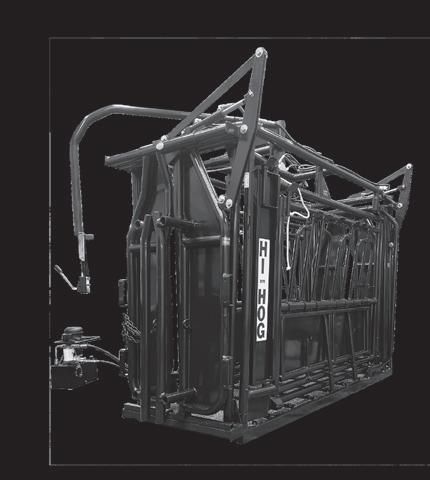

BY ANGELA LOVELL
Several economic and market analysts gave an overview of the economic and market factors they see as having the biggest impact on the Canadian beef industry over the year ahead during the insights component of the Canadian Beef Industry Conference (CBIC) in Saskatoon in August.
The following are highlights from the panelists.
Brenna Grant – Executive Director of Canfax: Is the Canadian herd expanding?
The biggest question across the Canadian beef industry today seems to be has herd expansion already begun and what impact will it have on the profitability of the sector?
For expansion to take place, there has to be heifer retention and there are some signs that is starting to happen, albeit slowly, said Grant. “We are seeing the cow herd stabilizing with lower cow marketings, and just the start of incremental improvements in heifer replacements, with some retention starting to take place,” she said. “We are not expecting to see much heifer retention until into the fall run when we see what the cow/calf producers are doing, what their pastures did this summer and how they are situated financially.”
Beef supply, demand and prices
management is key at these high prices.”
Graeme Crosbie, Senior Economist at Farm Credit Canada: Inflation rates, wage and employment rates, interest rates and exchange rates
There are some positive changes to these macroeconomic factors that all affect the consumer’s ability and willingness to spend money on beef and other food items.
The core inflation rate in Canada fell to 2.5 per cent in July, its lowest level since March 2021 and on the way to the Bank of Canadas target of two per cent. Food inflation is also down from 10 per cent year over year growth in 2022 and 2023 to 2.1 per cent today.
Interest rates have been falling in 2024, and are expected to fall by another 25 basis points by the end of the year and another 75 basis points throughout 2025. That should be good news for consumers, who are among
employment growth and at the same time an increasing population.
Where is beef consumption heading?
Food and beverage retail sales in the first half of 2024 have been down 2.7 per cent and in many cases, consumers are just purchasing less food. Canadian food manufacturers are generally looking at pretty anemic sales for the year. But although the price of beef has increased by 25 per cent over the last three years, and domestic consumption has declined, demand still remains high relative to consumption.
Travis Hickey: Cattlenomics
There are opportunities ahead of us and reasons to be excited but it’s not going to be easy, Hickey said.
Cattle numbers, beef demand and international trade Exports
The good news is that we are seeing really high beef prices at wholesale levels, and there is continued high beef demand. As well, retail margins for beef in 2024 have been higher last year or in recent history. That should support high prices going forward.
Although there has been a modest reduction in beef production across Canada, there has been an increase in carcass weights that has kept the supply relatively steady. But will beef prices in the grocery store remain high over the upcoming year and what will affect them?
the most indebted in the world, with 15 cents of every after-tax dollar they earn going to pay debt. This ratio is expected to increase over the next two years as mortgages renew into the current interest rate environment.
The US dollar is stronger than it has been in decades, but Crosbie believes it will find some support later in the year when the US Federal Reserve beings cutting
International beef demand is expected to remain high in the year ahead, with the biggest importers being South Korea, Japan, China, and the United States. While beef production and slaughter were down in the US and Canada this year, Brazil is expecting to slaughter more than 450 million cows, and slaughter numbers are also up in Argentina. Brazil’s beef exports are up 32 per cent over last year, with most going to China and demand there is expected to demand strong, although Canada isn’t currently exporting anything into that market.
Cattle numbers and production

Wage growth should fall over the year ahead to the one to three per cent range (down from 4.5 per cent over the past two years. Meanwhile, the employment rate declined after the recovery from the pandemic in 2022 and is now below 61 per cent, so there is stagnant total

The beef cow inventory in the US is smaller than in the last two years, and it’s likely the calf crop will be smaller based on the number cows to begin with. Meanwhile there are record high numbers of heifers on feed. There are also more dairy calves going into the feeder supply, although that’s predicted to decrease in the year ahead. Production has held steady because carcass weights are five per cent higher than last year, and the US has also been importing cattle from Brazil and Argentina.
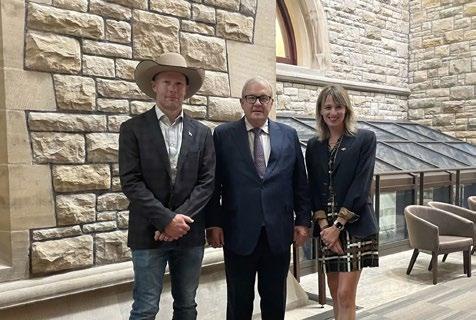
Lois McRae & Joyce Gordon RR 1 Box 57 Brandon, Manitoba R7A 5Y1 h: 204-728-3058
c: 204-573-5192 f: 204-727-7744


marmacfarms1@gmail.com
BY ANNIKA SUND
Hi, my name is Annika Sund! I am 18 years old and grew up on a black and red angus cow/calf operation in Woodlands. My earliest memory of living on the farm is walking with my great grandmother on our way to see the calves. I was about four during that time and it’s still one of my favourite memories to this day. I loved growing up on the farm and cannot wait to start my own once I am graduated from my degree in Animal Science! The beef industry means so much to me and my family, it is our way of providing for not only us but everyone else.
To my family the beef industry is our life. We go every day rain or shine, snow or sleet to take care of our animals. They are our way to provide. Growing up on a farm teaches you a multitude of skills ranging from animal husbandry to business management. My family always ensures our herd health and an appreciation for nature.
BY LAINIE MUIR
Prices and productivity. Think about recent thoughts, conversations, or information you have seen in the media relating to the beef industry. The product prices in grocery stores, climate crises, or animal health are common topics that may surface in your mind.
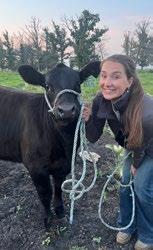
In my experience as a producer and someone who is passionate about the beef industry. I’ll often think and talk about things like the successes and failures I had in the most recent calving season. What I do not think about as often is something like the experience I had the last time I ate a steak with my family. To draw a conclusion from this, myself and others seem to consider aspects of the beef industry that relate to economics, the environment, or the livestock themselves more often than we consider aspects of another integral component of the industry ‒ its cultural and social impact. This does not suggest
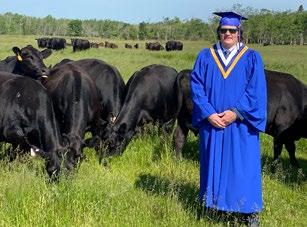
BY KEENAN KARISH
My name is Keenan Karish and I am proud to say I am a 5th generation beef producer in the Interlake. My family has owned and operated our farm located west of Fraserwood for well over 100 years, raising Black Angus cattle. I am currently attending the University of Manitoba where I plan on completing my degree in Agriculture and then applying to the Western College of Veterinary Medicine in Saskatoon. Finding a balance between my academic success and staying committed to my family farm has proven to be a challenge, commuting home every weekend during the semester. However, I have been able to remain successful in both ventures thus far. My family
For my community, the beef industry affects many different sectors. It provides many employment opportunities within my community. The beef industry is part of the identity here in Woodlands; it has ingrained itself as part of our culture in our town. For our community, the beef industry has helped our land continue to be the best it can be with sustainable and natural practices of cattle grazing and habitat development for plant life and wildlife.
The beef industry supports Manitoba majorly with the revenue it brings into our economy. It supports our veterinarians, feed suppliers, equipment dealerships and manufacturers, pharmaceuticals firms, truck drivers and the people who raise the cattle to make this possible. It gives many opportunities within the industry and provides Manitoba with beneficial and environmental effects. Cattle pastures in our province provide safe habitats for wildlife and native plant species. Pastures improve the water cycle by slowing run-off and reducing flooding.
that the economic and environmental aspects of the industry are more important, it simply shows that people may overlook its cultural and social significance, This realization motivated me to focus on what the beef industry means to my family, my community, and Manitoba from a cultural and social point of view.
My family is connected to the beef industry through three generations of producers. My grandparents established a herd of beef cattle and my family has maintained our involvement through production since. This generational involvement in the beef industry has created our heritage and shared values. My family is built on a strong sense of pride and connection to the land we work on, and our values encompass hard work, responsibility, and respect for animals and nature. Our involvement with beef cattle has also led to many traditions. From the Easter brisket my aunt prepares, to the sleigh rides across the trails of my grandparents’ home quarter at Christmas, to working together in the meat shop to fill our freezers. The beef industry has incredible cultural and social meaning to my family, shaping our relationships and the time we spend together.
Reaching beyond my family, the cultural and social aspects of the beef industry are equally as important in my community and Manitoba. In
has supported me through my school life end my work on the farm; their support is priceless, but this effort comes at a cost.
Growing up on my family farm has not only shaped the person who I am now, but the man I strive to become in the future. Farming has taught me to overcome adversity and be resilient in trying times. With the weather being extremely uncertain, like every producer, my family has had to discover more efficient and sustainable ways to overcome the challenges they face. The climate crisis is only going to get worse, making the already unpredictable weather patterns a heightened hurdle for the agriculture industry. However, seeing what my family has persevered through, from droughts and floods to BSE and COVID, I know there’s always a light at the end of the tunnel; you just have to find it
The Interlake is a place known nationally as “cattle country”; several producers outside of Manitoba choose to pasture their livestock here. Unlike many other regions in Manitoba, the Interlake is home to thousands of acres of trees above ground while below ground, a bumper crop of rocks awaits. Although unsuitable for grain production, cattle thrive on these marginal lands. They can utilize this native prairie landscape, not only increasing carbon sequestration by promoting new plant growth, but ensuring our industry is sustainable now, and for the foreseeable future.
I am proud to be raised within the beef industry. It has given me a sense of pride to be able to raise and care for these animals and to provide for the people. It has taught me respect, passion, hard work, and grit. I am so excited for the day, that I get to build my own cow/ calf operation and use sustainable practices. When time comes, I cannot wait to raise the next generation to advocate and love this industry as much as I do.

Manitoba we have 6,715 beef cattle farms spread out across the province. Manitoba was built on the success of rural communities, and every single one of these communities is deeply connected to the beef industry. My community and others across Manitoba can be characterized by agricultural fairs, general stores, and family-owned restaurants. Think about a local farmer’s heifers on display in July that the kids in the community look forward to seeing all year, the rural general store that has stayed in business through time with the support of the surrounding cattle producers, carrying lick tubs and calf starter, or the family-owned restaurant in a small town you go to for a Saturday buffet that serves beef from the farmer down the road. These are all subjects of extreme cultural and social importance created by the beef industry, which defines our communities and makes Manitoba unique.
The beef industry is a diverse one. As residents of Manitoba, we are all culturally and socially connected to beef through various aspects of our lives, from family traditions to the communities we are a part of. If you get a chance, take some time to remind yourself of the cultural and social impact of the beef industry in your own life. Be proud of your connection to beef whatever it may be, you’ll be surprised to learn how far the impact of the industry can reach.
My grandfather has always said “if you love what you’re doing, you will never work a day in your life.” Although times can and undoubtedly will be tough, I love every part of this industry. From watching calves become cows, making hay during the hot summer months and even the 2 am calving checks in -40, I wouldn’t want it any other way. The people involved in this industry you cannot find anywhere else; always willing to lend a hand, share advice, or go for a coffee on that rainy day. Farming is a lifestyle that demands time, effort, community support, and personal adaptability. Not only am I extremely proud to take on this lifestyle and continue my family s legacy, I am also supported by the past four generations that have paved the way for me to succeed and stay motivated.
I believe the future of rural communities in Manitoba is dependent on the occurrence of agricultural practices. I plan on returning to Manitoba following the completion of my postsecondary education, to bring forth innovative ideas to modify the traditional way of farming, and ultimately, support a sustainable industry. Farming is a way of life, and without effective and efficient farming activities, the growth and viability of rural communities and small towns would suffer. My history of rural farming and small-town experiences have validated the importance of working together. The ongoing support for local, rural communities is truly the heart and soul of this province, and the future of Manitoba.
BY MADISYN ROBERTSON
My parents, grandparents and great-grandparents have all come from an agricultural background. Our family operation consists of grain and a cow/calf pair operation. My agricultural upbringing has provided me with a great love and desire to continue on the family legacy.
The beef industry is a livelihood where our good friends are considered family. It is a team effort to produce and market our beef to the best of our abilities. I have had a very active role on our family farm, specifically on the cattle side. I am responsible for feeding my show animals and 4-H projects, along with overall herd health. I enjoy examining the benefits of different beef breeds and figuring out what crosses will benefit. I am interested in watching how beneficial cattle are to the natural landscape and how the byproducts of beef production can assist in maximizing our potential crop yields. My fondest family memories and experiences involve the cattle ‒ whether it be summer pasture checks with a stop for a picnic, snuggling a newborn baby in the dead of winter or watching the
BY MEGAN BESWITHERICK
My parents took a great risk shortly after they had taken over the family farm by switching from a familiar, generational dairy operation to a less familiar beef operation. There were many sleepless nights and unpaid bills as BSE hit Canadian beef farmers only a few years after the farm made the switch to beef. There were only two options to be made in this situation: sell the cattle, or take any means to stay afloat and keep the cattle.
To my parents, the only choice was to fight to keep the cattle because the beef industry meant everything to my parents. This meant creating new off-farm and on-farm businesses to attempt to cover losses until the storm had passed. Looking back now, I am so grateful that my parents worked so hard to keep the cattle because my sisters and I would not be who we are without the experience of working hard on the farm. The beef industry means everything to my family because it is not only our livelihood and our passion, but it has also brought us closer together by teaching us hard work and how to help when someone needs it.
Not only does my family care deeply about the beef industry, but so does our community, the
BY SHAYLA WOYCHYSHYN
Rooted in the prairies and fertile lands of Manitoba is a deeply ingrained tradition of agriculture in its many forms, from the traditions of Indigenous peoples to the first plows breaking the soil, and modern-day innovations that make agriculture what it is today. Manitoba’s agricultural heritage runs deep, passing through generations of hard working and resilient farmers, ranchers, and scientists.
Throughout my life I’ve made many fond memories tied to my family’s agricultural involvement, from my uncle’s stash of harvest snacks in the grain truck, to halter breaking 4-H calves with my dad and a first date with my boyfriend being a ride in the combine. These memories not only serve as a bit of nostalgia, but also reflect a couple of ways that agriculture has impacted my life.
calves run and play.
The beef industry offers numerous life lessons – life and death, work-life balance, financial responsibility and a free gym membership. Our cattle provide free fertilizer, a means to use byproducts such pea straw and the opportunity to graze areas we cannot farm.
As mixed farmers, we rarely get breaks. 4-H activities and cattle shows offer my family a “vacation” where we can connect with other breeders and network.

My community is a solid agricultural hub, and the beef industry is integral to our economic success. We have several large equipment dealerships, two large ag supply companies, and two veterinary clinics that the numerous beef producers in the area support.
I look forward to attending the University of Saskatchewan to study Animal Sciences. I have a
Municipality of North Norfolk. Being a community that is filled largely with grain and cattle operations, the community centers many of its efforts on the farmers that keep the community running. My community appreciates the work that the farmers do. From fundraisers to school tours to community events, the beef industry is in every part of our way of life in North Norfolk. The beef industry means a source of sustainability in the community and also a source of pride towards the hard work of the farming community.
strong interest in genetics and want to find ways to minimize the water and land needed to produce the same amount of beef within that year as we had years before. Valuable land continues to be eaten up by crop production and urban expansion. To save the beef industry in Manitoba, we must be able to do more with less.
With marginal land in our province unsuitable for crop production, beef production is essential to reducing the risk of wildfires, sequestering carbon, and providing a safe habitat for wildlife.
The beef industry is my family’s passion. As cattle inventory numbers continue to drop and the average age of producers in Manitoba increases, I look forward to returning home and working hard on our cow/calf operation, increasing our efficiencies and breeding the best cattle we can.

The beef industry is also extremely important to Manitoba because it is one of the agricultural products that helps to keep Manitoba relevant for exporting beef from Canada. Manitoba is the third largest beef-producing province in Canada with about 12% of the national beef herd that resides on the vast grasslands in the summer and is kept healthy on feed in the cold winters. Without the beef industry, Manitoba would have to import beef from neighboring provinces, which would increase the cost of beef upon

in shaping my understanding of agriculture and fostering my passion for the industry. During my time with the Erickson 4-H Club I gained valuable hands-on experience in animal husbandry, leadership, and communications, all while getting to experience a sincere community connection. Even though my time as a member of the club is over, I’ll be retuning as a ring person to both the club achievement, and Neepawa Fat Show in the summer, to offer my support as past members have for years before me.
While learning the value of hard work and responsibility, I’ve also developed an extensive appreciation for the interconnection of farming, the environment, and the community involved. Furthermore, my involvement in 4-H has played a significant role
Many of my experiences have allowed ne to recognize the importance of agriculture, including the beef industry, to communities and the province, extending far beyond its role in food production, whether it’s the role it plays in sustaining livelihoods or bringing people together. Although agriculture provides jobs to producers and farmers, it also directly provides employment opportunities in research, finance, food services, marketing, retail, transportation, and so much more. Not only is there an economic relationship between farms and communities, but also a level of mutual respect and support.
the fast-rising inflation rates, making it less affordable for Manitobans to purchase the protein they require. Overall, Manitoba needs the beef industry to remain a province of strong trade power to the rest of Canada and the rest of the world.
Not only is the beef industry extremely important to my family, my community, and Manitoba, but it is also important to me. One of the greatest honors in my life is being a part of the beef industry in Canada because it is a community that is filled with people who so graciously devote themselves to the industry, even if the weather and the world may not cooperate sometimes. I also enjoy being involved in the agriculture industry because I am proud of the fact that if a neighbor is in trouble, agriculturally or not, the ag community will always be there to help in any way that they can. Last but not least, I love the beef industry because of the animals. Being able to see the creatures that you pour so much time and effort into flourish from your due diligence is unlike any other experience.
Additionally, farmers and ranchers serve as stewards of the land, recognizing the value of sustainable farming practices, soil conservation, and maintaining wildlife habitat and water resources. The future of agriculture can’t be the past. With increasing populations and higher demands, beef producers are adapting, and working hard to preserve their land. Whether it’s rotational grazing or intercropping forages, they’re constantly balancing range health and cattle production.
With a passion for agriculture and environmental preservation, I’ll be a completing my diploma in Environmental Conservation & Reclamation at Lakeland College in Vermillion, Alberta. During my time at Lakeland College, I’ve enjoyed a vast majority of my courses, but have especially enjoyed courses in rangeland management, soil conservation, invasive plant management, and soil fertility.
In the 2024/2025 school year I will be transferring to the University of Saskatchewan to pursue a degree in Agriculture and Bioresources with a major in soil science. Once I graduate, I’m planning to continue growing my small commercial Simmental herd. With my combination of post secondary education and life experiences, I hope to play a role in the management of Manitoba’s agricultural land, to ensure the province can sustain its tradition of agriculture for generations to come.
The 2024 fall calf run is on! To date, calf prices have settled very close to last year’s prices on the steers and added strength on the heifer market. The yearling run is all but over, with prices recovering from the market drop, but not to the levels prior to the stock market crash. The market for confinement yearlings and yearlings over 1,000 pounds all but evaporated, making them a very tough sell.
The demand for calves is strong from Ontario which has very good crops, despite wet weather. Alberta is a contender on the calf market, while American orders are nowhere close to the Canadian calf market. Some feeders are looking at importing calves from the US. To date, pen space has been slow to open up, with some of the packers buying cattle today for harvest in four to five weeks.
The seasonal correction for the cull cows started with the American packers taking over 13 cents per pound off their orders. Canadian packers were more competitive, despite killing fewer cows per shift. JBS was the major cow buyer the past few weeks, with some of the specialty plants propping up the Manitoba cow market.
Feed supplies are much larger and cheaper than last year at this time. This should keep the calf market

RICK WRIGHT
at current levels. It has been very hard to find out the custom backgrounding rates in Manitoba for this fall. Most of the custom feedlots are trying to hold onto last year’s prices, while the cattle owners are citing considerably lower feed prices and are expecting lower rates. The majority of the custom feeders are opting to charge for feed in the bunk and daily yardage rather than a set cost of gain and gain restrictions.
Regardless, there will be a strong demand for Manitoba calves again this fall. The good pasture conditions holding into mid-October are delaying some calf deliveries, which will fill up the peak of the season sales very quickly.
The cattle market has always been a supply and demand driven market. The demand end of the formula is driven by the demand for beef products at the retail level, combined with the export demand outside Canada. The supply side of the equation is the cattle numbers combined with the pounds of beef produced each month.
It is no secret that the North American cow herd is at its lowest level in over 50 years. Opinions differ as



• GRASSFED: “True North Foods is partnered with A&W Canada to supply Canadian grassfed beef for A&W’s grassfed burger program.
• SERVICES: Whether you are a specialty producer looking to get your product to a speci c market or distributor, or if you are producing commodity livestock for sale, we can partner with you. From our multi-species capabilities to our ability to handle smaller volumes, we o er excellent capabilities for producers in the Canadian Prairies to maximize their pro tability.
to whether we have reached the lowest inventory point, or if the cow herd is on the brink of transition, with the rebuild right around the corner. Beef cow harvest was down considerably in the first three quarters of this year. That decline should have signalled the end of the liquidation phase. The lack of heifer retention offset the decline in the cow slaughter, resulting in continued liquidation. If the lack of heifer retention continues, beef cow slaughter will have to decline another 25% to stop the overall liquidation.
Currently in Manitoba, many producers are selling their steer calves and keeping their heifers at home. This in no way means that these heifers will go into the breeding programs and be the start of the rebuilding process. The producers have always hated the spread between the steers and heifers and are hoping to get some value added to their heifers by adding weight and taking advantage of the cheaper feed. In Manitoba, there are a large number of good reputation cow herds for sale this fall. Some producers will consider buying a bred cow rather than keeping heifers to breed. Today that might be a good option, but some day soon, industry will have to go back to breeding heifers before the cow herd gets too old.
Most experts feel that expansion will not start until 2026 at the earliest. In the cattle world, the rebuild of the national cattle herd starts to show up two years after the start of major heifer retention, when those first retained heifers start producing calves that will be sold. If you use that scenario, it means it will be 2027 before we see any signification increase in the beef herd. The experts also caution that any drought conditions could delay heifer retention even further.
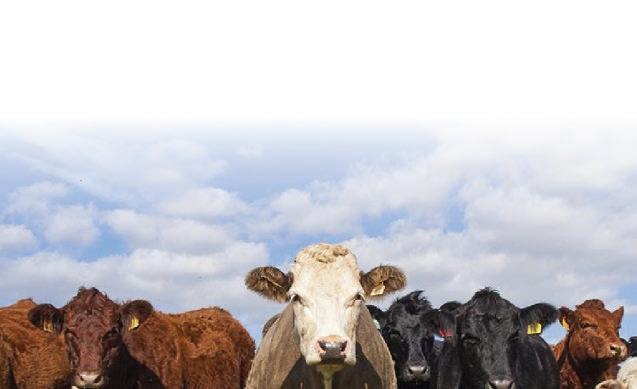
• FACILITY: We have a state-of-the-art facility to allow us to reach markets across Canada, the USA, and beyond. We understand producer’s needs, their care for their animals, and their honest, straightforward nature. Call us to hear how we can work together to get your product to market. www.truenorthfoods.ca | trever.frattinger@truenorthfoods.ca | 306-536-6193
When it comes to beef demand, consumers are showing resistance to the current retail beef prices. I mentioned in a previous article that beef had the potential to become a luxury food the way lobster is. I think we’re very close to that point right now. Inflation at the grocery stores has hit every consumer hard in the pocketbook, with little relief on the horizon in the protein market. If the export demand weakens for Canadian beef, the packers and wholesalers will not be able to pay the current prices. That is good new for consumers, but bad news for the producer and feeding sectors. We need the current or better beef prices from the packers to support the current cattle prices. Many producers tell me they need more than the 2024 prices to stay in business, due to the increasing costs of operating a cow/calf operation. The future of the family beef farm is not as bright as it once was. Pork prices remain under pressure, and budget-conscience consumers are using pork as an alternative protein choice to beef.

All the market indicators are pointing to a strong calf market for the fall. Early sales are reporting that calves fresh off the cows are weighing more that last year. More pounds to sell on a steady market? Pretty good news for cow-calf producers.
Until next time, Rick







Kristen Bouchard-Teasdale Livestock Specialist Manitoba Agriculture
Kristen.BouchardTeasdale@gov.mb.ca
Question: When is the best time to assess your cows’ body condition?
Answer: Body condition scoring is a hands-on method of measuring the amount of fat cover a cow is carrying. In Canada, body condition of beef cattle is scored on a scale from 1-5, with 1 being very thin and 5 being obese. A cow in ideal condition will land right in the middle, with a score of 3.
Body condition scoring is quick, inexpensive and simple to learn. Using your hands, feel for the amount of fat covering four key areas of the cow’s body. This includes the short ribs, spine, the hooks and pins, and either side of the tail head. An animal in optimal condition will have a thin layer of fat in these areas, and it will take some pressure to feel the bones. In under-conditioned animals, the bones will be very noticeable and sharp. In overweight animals, individual bones cannot be felt through the layer of fat.
Monitoring body condition throughout the year is worthwhile because it can have a significant impact on your cow herd’s productivity. Cows with a body condition score (BCS) of 3.0 rebreed up to 30 days sooner than thin cows. This results in more cows calving within the first 21-day cycle and heavier calves at weaning since they’ve had more time to grow. Additionally, cows in ideal condition have higher pregnancy rates (double those of thin cows), experience fewer abortions and have less difficulties calving. They also produce more colostrum with higher levels of antibodies leading to stronger, healthier calves.
Body condition scoring in the fall (often when cows are brought in to be pregchecked) is particularly useful because it allows you an opportunity to assess the condition of your cattle coming off pasture. It may also lead to earlier detection of health problems in individual animals. A targeted management strategy and feeding program can then be developed to ensure each member of the herd is in the best possible condition for calving season.
Thin animals (BCS of 2.0 or less) should be removed from the main group as soon as possible and managed to increase their body fat reserves. Timing is important, because it is easier and less costly to improve a cow’s condition in the fall versus in
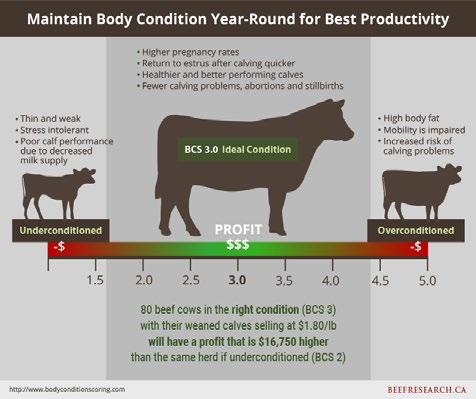
from a BCS of 2 to 3. To make this change in 90 days requires 20 per cent more energy than a cow that is maintaining her condition; to do it in 60 days requires 30 per cent more energy. It will be 20-30 per cent more expensive to improve condition during the winter.
Successful reproductive performance in the spring, depends on nutritional planning in the fall. Taking the time to body condition score the cow herd is an important part of the ration planning process. For more information on body condition scoring, including an interactive calculator illustrating the effect of body condition on a cow’s productivity and the value of her weaned calf; visit the Beef Cattle Research Council at www.beefresearch.ca/tools/body-condition/#tool
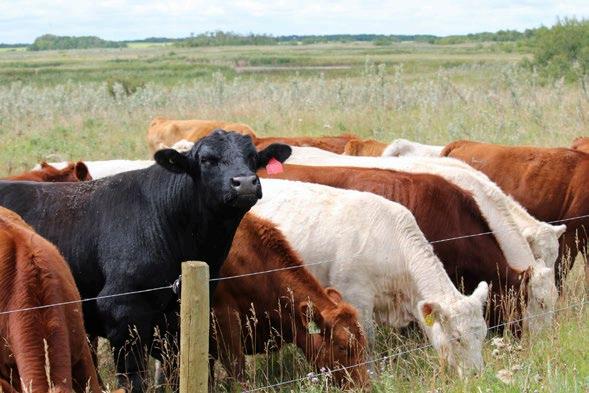
References: Beef Cattle Research Council. (2023, September 8). Body Condition Scoring. https:// www.beefresearch.ca/tools/body-condition/#tool



In the next issue of Cattle Country, a Manitoba Agriculture forage or livestock specialist will answer a selected question. Send your questions to Elizabeth. Nernberg@gov.mb.ca.
StockTalk for Cattle Country is brought to you by Manitoba Agriculture. We encourage you to email your questions to our department’s forage and livestock team. We are here to help make your cattle operation successful. Contact us today.
Andrea Bertholet Killarney 204-851-6087
Andrea.Bertholet@gov.mb.ca
Kristen Bouchard-Teasdale Beausejour 431-337-1688 Kristen.BouchardTeasdale@gov.mb.ca
Shawn Cabak Portage 204-239-3353 Shawn.Cabak@gov.mb.ca
Pam Iwanchysko Dauphin 204-648-3965 Pamela.Iwanchysko@gov.mb.ca
Cindy Jack Arborg 204-768-0534 Cindy.Jack@gov.mb.ca
Juanita Kopp Beausejour 204-825-4302 Juanita.Kopp@gov.mb.ca
Elizabeth Nernberg Roblin 204-247-0087 Elizabeth.Nernberg@gov.mb.ca
BY: DR. TANYA ANDERSON, DVM
Knowledge is power and keeping up to date with much of the recent progress in beef cow/calf management can be daunting for producers. It is easy to fall in the trap of continuing to do what one has always done because it works. And it may still work but the efficiencies, both in time and money, may have changed such that it really isn’t working anymore and your operation is starting to slide. In other situations, what worked now begins to fail, but delays in detection can mean that slide can become precipitously steep and result in economic non-viability before one realizes.
Assumptions can be dangerous. Doing what your neighbours or friends do in their beef operations may not be the right thing for you. This is why it is critically important to generate your own data by keeping accurate records so you can measure your progress. Comparing your operation to regional benchmarks can help you see where you can improve but keep in mind that these benchmarks are industry averages and they can and do change. Set your own goals for improvement in areas that matter to you ‒ weaning weights, cow fertility, calving ease, animal or pasture health, etc.
This past summer was a challenge for many of my clients. There were herds that struggled with foot rot and/or pinkeye. Others had problems that they had never seen before ‒ late winter calving cows down with milk fever in pasture, cows with skin issues, calves with swollen knees and many non-responsive lamenesses despite accurate diagnoses. Many clients reported unprecedented mineral consumption early in the grazing season despite adequate mineral provision through a
winter TMR. Fall pregnancy testing is just starting and initial results show fertility levels to be variable, though better than last year.
Many of the above mentioned issues had me digging into mineral and vitamin nutrition. The more I dug, the more confused I got as there were many conflicting opinions for how to correctly diagnose a problem and, similarly, how to solve said problem. What did become universally apparent was that one can no longer assume that soil, feed and water nutrition remains as in the past. This is not surprising though as weather patterns and land/water use has changed. Recent research in Saskatchewan has indicated that all forages in spring are deficient in copper and zinc. Dr. Cheryl Waldner of the Western College of Veterinary Medicine stated “If you are a cow-calf producer in Canada, you need to worry about copper supplementation in your herd regardless of your location.”
I have previously talked about the concept of PEM ‒ Protein Energy Malnutrition and I believe that malnutrition during critical stages in a cow’s production cycle (late gestation and early lactation/ pre-breeding) sets up the herd for later imbalances of trace minerals and vitamins. When protein and energy are correct, mineral health and vitamin status improves with appropriate supplementation. Cows attacking the mineral feeders and dropping condition rapidly on late spring pastures was not just a sign of low minerals but also a sign of protein and energy imbalance. Lush green grass has less nutrition ‒ it is full of water. In the case of the client with downer cows, it was likely also high in potassium which lowered effective calcium homeostasis and caused downer cows despite what appeared to be
adequate mineral supplementation.
Is testing soil, forage on pasture and post harvest, and water the solution? I don’t know. I suspect that this will help many producers make sound decisions re: when/what to supplement but I know that those services are not always available and, just as for veterinarians, there is a shortage of nutritionists and provincial extension staff to provide those services. If that option exists in your area, it would be worth pursuing.
I do think that monitoring blood and liver levels of minerals and vitamins is a good initial step when working up health issues in cow/calf herds. Fall processing is an ideal time to have samples pulled. A critical first step would be evaluating the ration, either as a review of the feed tests with formulated ration or, if no paper ration exists, inputting the “ballpark” ration into a ration-balancing software program. In many cases, protein and/ or energy deficiencies will be seen. It may also become apparent that there are mineral or vitamin deficiencies or imbalances occurring. Then individual animal testing of those with clinical signs and those at critical life stages (heifers, first calvers, older cows) can be used to confirm the issue and be the impetus for action.
Avoid relying on quick fixes like injectable minerals and do your homework when comparing loose, block or tub mineral products. Pricing and supplemental levels vary. Many include other ingredients that may not be suited for your operation. Avoid over-supplementation which increases costs and may create antagonistic reactions and adverse health conditions including death. Get a diagnosis first and then develop a long-term solution to the problem. Use this knowledge to propel your operation toward your goals.



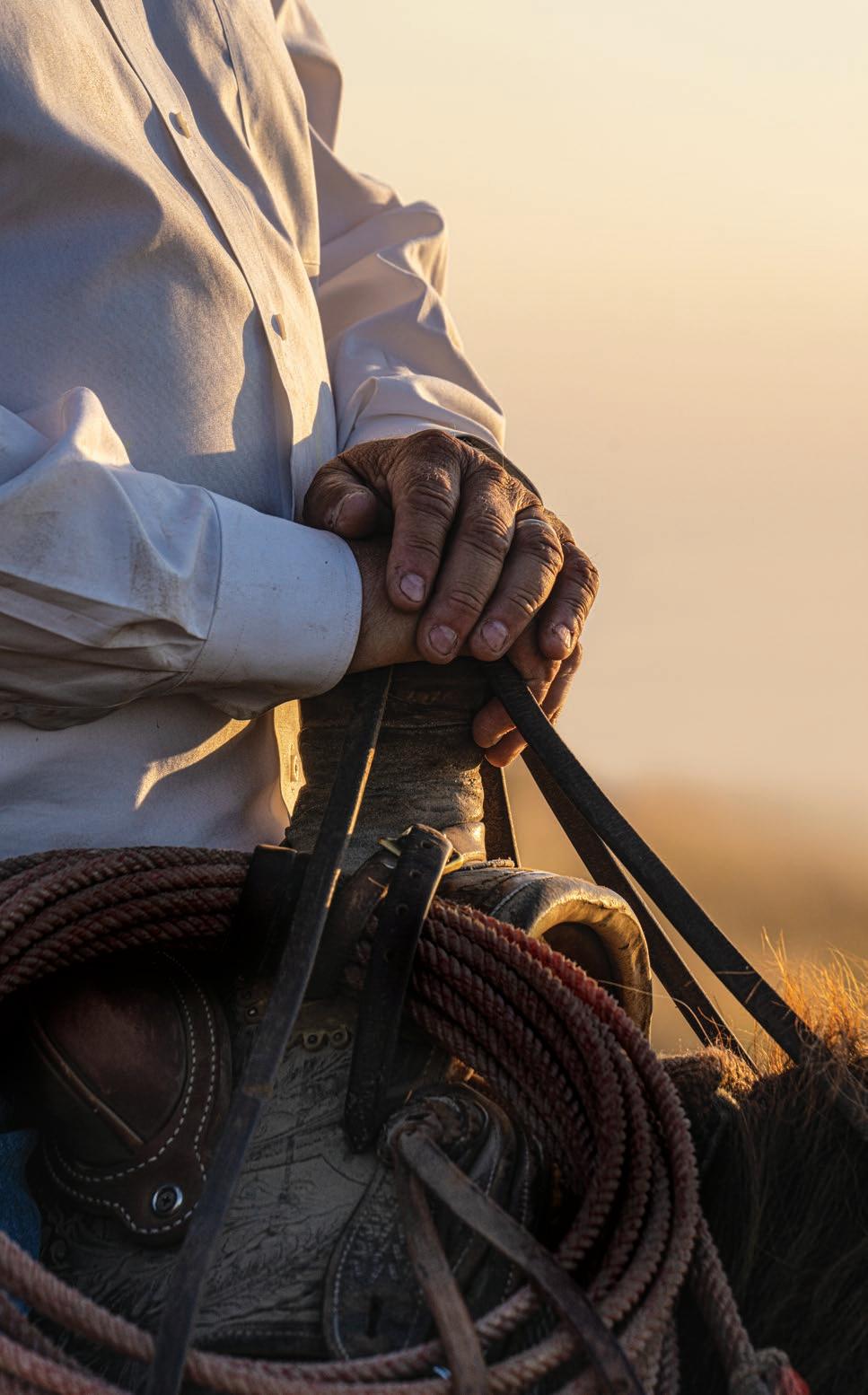

BY PETER FROHLICH WITH CONTRIBUTIONS FROM MICHELLE CARKNER, JOANNE THIESSEN MARTENS, AND THE LEAP TEAM FROM THE
Researchers from the Faculty of Agricultural and Food Sciences (FAFS) at the University of Manitoba, University of Saskatchewan and several partner organizations from across the prairies have received new funding from the Natural Sciences and Engineering Research Council of Canada (NSERC) to explore increasing the use of perennial cropping practices.
The new project is called LEAP (Leveraging Ecosystems to transform Agriculture on the Prairies) and Manitoba Beef Producers is among several industry partners supporting the initiative. The goal of the project is to generate information, tools and management practices required to create sustainable, resilient and profitable net-zero emissions farming systems using
to the landscape in other ways. The term “function” is meant to add a certain quality (for example, year-round soil cover) that serves a beneficial purpose in a cropping system. In addition to environmental benefits from perennial crops, perennial function can be added to annual cropping systems by planting cover crops, perennial pollinator strips, and maintaining or enhancing natural perennial features like wetlands, hedgerows or riparian zones on the landscape. Perennialization is perhaps the most powerful ecological tool in the quest for net zero.
During the four-year LEAP project, five multidisciplinary research teams will explore perennialized cropping systems from social and biophysical perspec-
Landscape analysis
During the planning process of the project, a consistent challenge that the team heard from farmers, producer groups, and agricultural policy advocates was lack of robust data about how well different farming systems help to meet environmental goals. Innovative management approaches are already being used by farmers and land managers across the prairies. The landscape team’s objective is to generate data from real farms and quantify the impact of including different degrees of perennialization. This team of 12 researchers is led by Dr. Joanne Thiessen Martens, with researchers from the University of Saskatchewan, and four departments within the University of Manitoba.
The new project is called LEAP (Leveraging Ecosystems to transform Agriculture on the Prairies) and Manitoba Beef Producers is among several industry partners supporting the initiative. The goal of the project is to generate information, tools and management practices required to create sustainable, resilient and profitable net-zero emissions farming systems using perennial cropping strategies – and systems that mimic some of the features of perennial systems – including those that integrate livestock production.
perennial cropping strategies – and systems that mimic some of the features of perennial systems – including those that integrate livestock production.
Perennial cropping systems
Perennial agriculture is the cultivation of crops that live longer than two years without the need for replanting each year. It includes the use of perennial forages, as well as new perennial grain crops. Perennial crops have numerous benefits as they maintain soil health, reduce erosion, and provide habitats for beneficial insects, wildlife and more. Typically, perennial crops (e.g. alfalfa) are used to support livestock production. However, this project is much broader as it also looks at perennial systems that are not exclusively dependent on animal production.
Perennialization can refer to the process of replacing annual crops (e.g. wheat) with perennial crops (e.g, alfalfa). But it also includes adding perennial “function”
tives. The research will include an assessment of current and new cropping practices on a ‘perennial spectrum’ and investigate the potential for farms to adopt new approaches in the future. Alongside consultations with partners, who would help inform research objectives, the teams will explore farmers’ experiences with perennialized cropping strategies and their willingness to adopt these strategies.
Additionally, researchers will document the social barriers to adoption and how policy may be developed to address adoption challenges. A special focus will be placed on Indigenous perspectives and what specific research and policy considerations need to be made within an Indigenous context as landowners and managers. At the end of the project, the goal is to create realistic, attainable, and economically viable management and policy recommendations to elevate farming to a sustainable, region-specific system for the future.
The team will monitor and quantify greenhouse gas emissions, crop productivity, biodiversity, soil health and how perennialization strategies that are already being implemented by producers support agronomic and environmental goals. The activity will compare commercial fields with low, medium, and high levels of perennialization practices on different soil types, with the goal of generating a large real-world dataset that will help to assess the roles of site conditions and management in meeting those goals. This data will be used to predict future scenarios using computer models and to generate tools to guide site-specific adoption of perennialization strategies.
Field experiments to assess net-zero farming systems
Replicated research trials that run in tandem with on-farm sampling provide a unique opportunity to ‘dig deeper’ into the “why’s” and “how’s” of different dynamics in cropping systems. Led by Dr. Yvonne Lawley in
collaboration with other departments at FAFS and the University of Saskatchewan, this team will investigate methods for implementing “functional benefits” of perennialized systems, such as cover crops, perennial grains, pollinator strips on marginal lands, and intercropping strategies. These strategies bring the potential to perennialize annual crop rotations by maintaining living plant cover into the spring and fall of the short prairie growing season. They also reduce fall tillage and create new opportunities for integrating crop and livestock production. The findings from these studies will be particularly useful for producers who want to transition to more perennialized systems. A bonus opportunity in the study will be to compare the energy use and carbon emissions of both a diesel and an electric tractor that will be used throughout the project.
Future farm scenarios
Farmer and partner input and data generated by the landscape and field research teams will direct and drive the modelling activities undertaken by the Future Farm Scenarios Team. The modelling team will be led by Dr. Marcos Cunha Cordeiro and supported by Agriculture and Agri-Food Canada (AAFC) data scientists. They will use the Canadiantailored modelling program Holos, developed by AAFC.
Saskatchewan and Dr. Kyle Bobiwash at the University of Manitoba, will engage First Nations communities. First Nations communities are keepers of traditional ecological knowledge and wisdom who play an important role in maintaining and implementing reduced emission practices in agriculture. First Nations groups are reconsidering their role in managing their agricultural lands. They are re-thinking what sustainable agriculture will look like and how agriculture can be practiced to fulfill the goals of food security, livelihood, and reclamation of cultural traditions. The team will work with First Nations communities to understand the
well-being is important to investigate because it may be related to on-farm decision making, the acceptability and adoption of various practices and preferred ways of sharing knowledge. The information gathered by the Farmer Engagement Team will assist in the design of the project’s methodology and it will help to identify producer perspectives regarding changes to current farm management practices that can be successfully implemented at the farm level.
How producers can be involved in the project
When we don’t heed the warning signs of poor mental health – things like mood swings, sadness, withdrawal, irritability, outbursts, loss of interest in things, sudden extreme shifts in behavior, sleep patterns changes, appetite changes and substance abuse – anxiety takes over and can becomes debilitating, but it’s important for people to understand that they are not alone.
The Holos model is a whole-farm modelling software that estimates GHG emissions based on production and weather data. This work will generate Canadian data that will allow farmers, researchers, and partners to explore transformative agricultural “what if“ scenarios. Modelling scenarios will provide answers to questions about how different perennialization strategies could be used to achieve agronomic and environmental goals consistent with net-zero agriculture. These scenarios and outputs can then guide policy initiatives to support farmers making changes in their production practices.
First Nations farming systems
The First Nations Self-Determined Farming Systems Team, led by Dr. Melissa Arcand at the University of
processes of diversity, integration and perenniality from a First Nations perspective. Together they will co-design beneficial management practices that achieve First Nations-defined goals and co-develop a research and adoption framework that First Nations can adapt and apply for designing self-determined farming systems.
Farmers are a key part of the research process
The Farmer Engagement Team, led by Dr. Meagan King and Dr. Kyle Bobiwash (UManitoba) in collaboration with the Canadian Centre for Agricultural Wellbeing at the University of Guelph, will capture and explore the invaluable lived experience of settler and First Nations farmers and land managers to ensure that they are all a key part of the project. The team will identify connections between farm management, farmer well-being (physical and mental), biodiversity, policy, and sustainability. Farmer

https://mbbeef.ca/our-news/district-meetings-manitoba-beef-producers/
Farmers and land managers can be a part of the LEAP project by becoming one of the sampling sites in the landscape activity, or participate in our farmer wellbeing study. Researchers will collect information and samples from fields with different types of management history, ranging from annual crops to perennial crops. They are particularly interested in the “in-between” fields – those that have some diversification or “perennialization” with cover crops, perennials in rotation or other approaches. The research team is especially interested in fields that support grazing livestock.
As a farmer participating in this study, you will be part of a research network across Manitoba and Saskatchewan, linking farmers, researchers, and partner organizations who want to advance sustainable agriculture. Participants will receive data on soil, crop, and biodiversity measurements from their fields and a summary of data from the farm network. You will also be invited to attend field tours and participate in other project events and activities.
For more information on how to be a part of the project and the other researchers and partners involved in this project, please visit: www.umanitoba.ca/agricultural-food-sciences/leap
Project Partners include the Manitoba Beef Producers, Keystone Agricultural Producers, Manitoba Forage and Grassland Association, Nature United, Manitoba Agriculture, National Farmers Union, and Ducks Unlimited Canada.
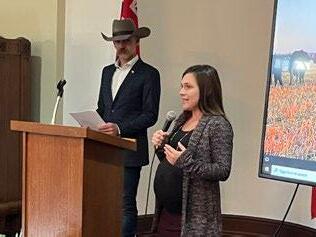

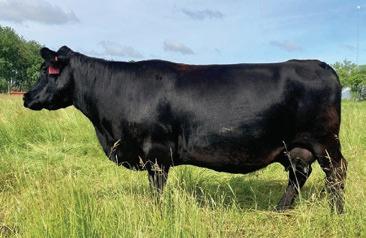
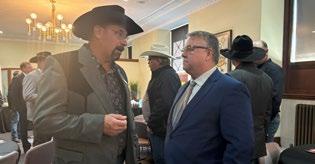

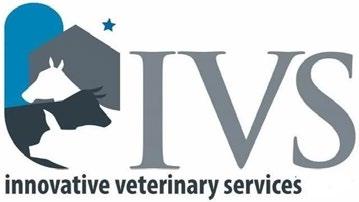
Healt H Manage M ent

BY: ANNA BORYS, MBP FOOD EXPERT
Cold weather is upon us, and although that could mean several things for different people, I think what I look forward to the most is a brand-new cooking season. And no, I’m not referring to my next episode of Season 35’s Great Tastes of Manitoba that airs on November 16 at 6:30 pm on CTV (shameless plug!), but I mean shifting from hot summery evenings of grilled burgers, smokies and s’mores to frosty wintry afternoons of slow cooked chili, braising meat and hearty soups.
As a chef, I’m often asked the impossible question of what my favourite thing to cook is and I think I’ve finally landed on an answer: soup. I think my love for making soup stems from using a broken twig to stir together water, dirt, rocks, sand and grass while in my 8-year-old
brain thinking it was the most rustically delicious stew. Or perhaps it was a favourite storybook of mine where Bert and Ernie are making vegetable soup for silly ol’ Cookie Monster, and the imagery of Bert slicing the onions, potatoes and carrots, then seasoning the giant pot of the heartiest looking soup that you ever did see. Even now, the thrill I get from meticulously chopping vegetables into the perfect dice or seeing how straight I can julienne a carrot brings the utmost satisfaction and enjoyment.
Of all my recipes I make at home, this one is easily the recipe I make the most and could make it in my sleep. As the weather gets colder, this recipe pops up more frequently in the rotation. I usually have portions frozen on hand for those quick lunch solutions or on evenings when time for cooking is limited.
Because of its versatility, I’m not sure I’ve ever made this Minestrone the same way twice, but that’s the beauty of soup, you really can put whatever you want in it! I normally stick with the usual onion, carrot, celery, tomatoes, beans and pasta in this recipe, however we also had half a zucchini, some leftover roasted butternut squash and the rind of Parmigiano Reggiano vacuum sealed in the freezer, so I threw all of that in as well. If there are any other odds and ends left in the fridge (like that bag of spinach you had originally intended for smoothies, the two tiny potatoes in the bottom of the bag, or a half-used crown of broccoli), there’s no harm in throwing those in either! Whatever you add, according to Cookie Monster, soup is arguably as delicious as cookies.
Happy soup season!
Ingredients: Spicy Fennel Sausage:
1lb Ground Beef, Lean
1 tsp Kosher Salt
1 tsp Garlic, minced
½ tsp Chili Flakes
1 tsp Fennel Seed, toasted
½ tsp Oregano, dried flakes
¼ tsp Black Pepper, ground
Minestrone Soup:
1lb Spicy Fennel Sausage
1Medium Yellow Onion, diced
2 ribs Celery, diced
1 Medium Carrot, diced
1 small Zucchini, diced
1 tsp Garlic, minced
3 Cups Butternut Squash, diced, roasted
4 Cups Passata, or crushed tomatoes
4 Cups Beef Stock, unsalted
1 small can Navy Beans, rinsed
3 tsp Kosher Salt
1 ½ Cups Ditalini Pasta, cooked al dente
3 Bay Leaves, dried
1 Rind of Parmesan Cheese
METHOD:
1. Add all ingredients for the Spicy Fennel Sausage to the bowl of a stand mixer fitted with paddle attachment and mix on low for 1 minute until evenly combined.
2. Heat large French oven over medium high heat. Brown the sausage, getting the smaller bits a bit crispy.
3. Add diced onion, carrot, celery and zucchini to browned meat and cook until softened, about 5 minutes. Add minced garlic and continue to cook for another 2-3 minutes.
4. Add 1 tsp of the kosher salt to the vegetables.
5. To deglaze pan, add passata slowly, scraping the bottom of pot to remove slightly burnt bits on the bottom.
6. Add beef stock, bring the entire pot to a boil then turn heat to low just to simmer. Add remaining ingredients, 1 tsp of the salt and allow to simmer for at least 30-45 minutes.
7. Taste soup and add remaining tsp of salt, or more if required. Remove bay leaves and cheese rind before serving.
8. Serve with your favourite crusty artisanal bread.
Yields 6-8 servings
